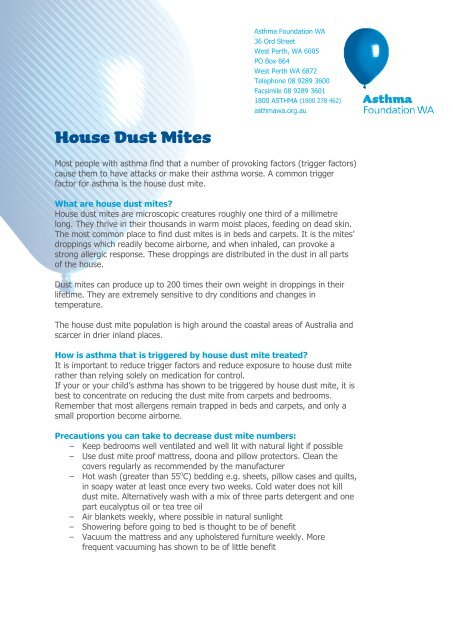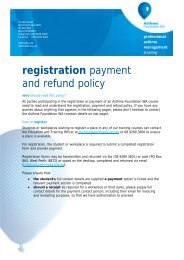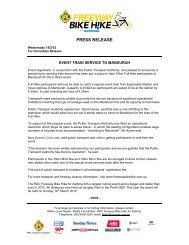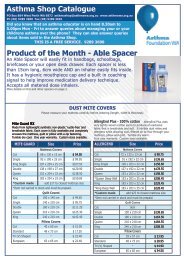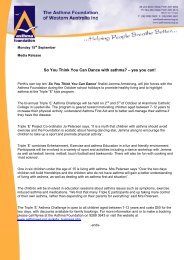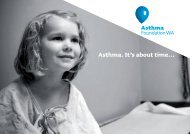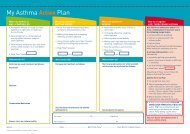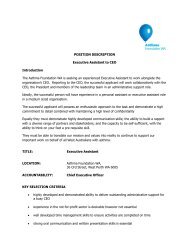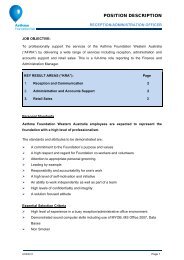House Dust Mites (PDF) - Asthma Foundation of Western Australia
House Dust Mites (PDF) - Asthma Foundation of Western Australia
House Dust Mites (PDF) - Asthma Foundation of Western Australia
Create successful ePaper yourself
Turn your PDF publications into a flip-book with our unique Google optimized e-Paper software.
<strong>Asthma</strong> <strong>Foundation</strong> WA36 Ord StreetWest Perth, WA 6005PO Box 864West Perth WA 6872Telephone 08 9289 3600Facsimile 08 9289 36011800 ASTHMA (1800 278 462)asthmawa.org.au<strong>House</strong> <strong>Dust</strong> <strong>Mites</strong>Most people with asthma find that a number <strong>of</strong> provoking factors (trigger factors)cause them to have attacks or make their asthma worse. A common triggerfactor for asthma is the house dust mite.What are house dust mites?<strong>House</strong> dust mites are microscopic creatures roughly one third <strong>of</strong> a millimetrelong. They thrive in their thousands in warm moist places, feeding on dead skin.The most common place to find dust mites is in beds and carpets. It is the mites’droppings which readily become airborne, and when inhaled, can provoke astrong allergic response. These droppings are distributed in the dust in all parts<strong>of</strong> the house.<strong>Dust</strong> mites can produce up to 200 times their own weight in droppings in theirlifetime. They are extremely sensitive to dry conditions and changes intemperature.The house dust mite population is high around the coastal areas <strong>of</strong> <strong>Australia</strong> andscarcer in drier inland places.How is asthma that is triggered by house dust mite treated?It is important to reduce trigger factors and reduce exposure to house dust miterather than relying solely on medication for control.If your or your child’s asthma has shown to be triggered by house dust mite, it isbest to concentrate on reducing the dust mite from carpets and bedrooms.Remember that most allergens remain trapped in beds and carpets, and only asmall proportion become airborne.Precautions you can take to decrease dust mite numbers:− Keep bedrooms well ventilated and well lit with natural light if possible− Use dust mite pro<strong>of</strong> mattress, doona and pillow protectors. Clean thecovers regularly as recommended by the manufacturer− Hot wash (greater than 55 o C) bedding e.g. sheets, pillow cases and quilts,in soapy water at least once every two weeks. Cold water does not killdust mite. Alternatively wash with a mix <strong>of</strong> three parts detergent and onepart eucalyptus oil or tea tree oil− Air blankets weekly, where possible in natural sunlight− Showering before going to bed is thought to be <strong>of</strong> benefit− Vacuum the mattress and any upholstered furniture weekly. Morefrequent vacuuming has shown to be <strong>of</strong> little benefit
<strong>Asthma</strong> <strong>Foundation</strong> WA36 Ord StreetWest Perth, WA 6005PO Box 864West Perth WA 6872Telephone 08 9289 3600Facsimile 08 9289 36011800 ASTHMA (1800 278 462)asthmawa.org.au− Carpets need to be vacuumed twice a week. Vacuum cleaners with HEPAfilters, tel internal (or triple) filters and electrostatic filters are the mosteffective against airborne allergens− Put fluffy toys in the deep freeze once every 2 weeks, for 4 hours orovernight− Damp dust weekly. This is more beneficial than feather dusting. <strong>Dust</strong> miteallergen is water-soluble. To prevent allergen being spread whilst cleaningall water used should be changed regularly− Minimise the number <strong>of</strong> items stored under beds and on top <strong>of</strong> wardrobesso that regular cleaning can occurSome points to be considered:− Fluffy toys should not be kept on the bed. It is preferable to buy toys thatare not fluffy− Avoid having carpets in the house or at least in the bedrooms. Timberand vinyl coverings are preferred along with other hard coverings, as theyare easily cleaned− Where possible, buy wooden, vinyl or leather furniture. Upholsteredfurniture can harbour the mite. If you have upholstered furniture, vacuumit weekly− Carpets should be short pile since long pile carpets hold more dust.Carpets can be wool or synthetic. The person with asthma should try toavoid doing the vacuuming. However, if this is unavoidable, weeklyvacuuming should be performed with the windows and doors open. Somepeople may also need to wear a face mask− After vacuuming, leave the house and allow the dust to settle for a halfan hour or so before re-entering− Wet and steam cleaning removes the mite from carpets more readily thanvacuuming. However, research suggests that it only improves it by twothirds and the residual water left in the carpet may promote fungalgrowth− Air filters are thought to have little effect on reducing asthma symptoms.− Dry cleaning kills the mites but again has little effect on the level <strong>of</strong> mitedroppings which is the aggravating allergen− Chemical control methods show only a moderate control <strong>of</strong> the allergens.The chemicals kill the mite but do not remove the allergen (thedroppings). There is some concern regarding its overall toxicity− Choose window coverings that can be easily cleaned
<strong>Asthma</strong> <strong>Foundation</strong> WA36 Ord StreetWest Perth, WA 6005PO Box 864West Perth WA 6872Telephone 08 9289 3600Facsimile 08 9289 36011800 ASTHMA (1800 278 462)asthmawa.org.au− Sheepskin products are best avoided, but if their use is essential, wash inhot water (55 o C) or place in the deep freeze for at least 4 hours orovernight every 2 weeks− Remember that dust mite allergy is to the faeces; just killing the mites isnot enough and the item should also be washedIt is important to remember that improvement <strong>of</strong> asthma symptoms occurs as aresult <strong>of</strong> massive reduction in dust mite allergens.We appreciate that this is difficult and that the above methods may only aid inreducing levels slightly. Skin testing for the dust mite and other allergens is mostuseful for patients with chronic/severe asthma.For further information and support, contact the <strong>Asthma</strong> <strong>Foundation</strong> WA on1800 278 462 or visit www.asthmawa.org.au


